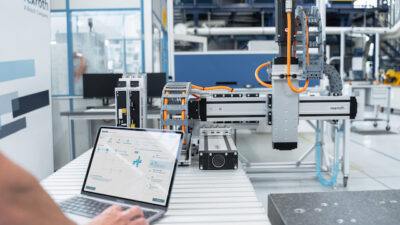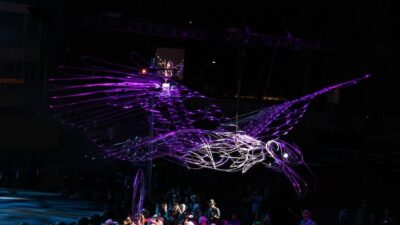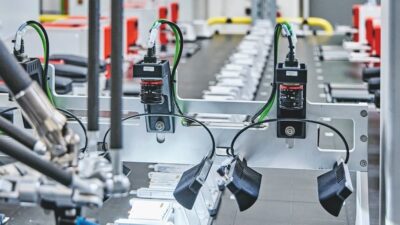'Integration and more integration" describes in the fewest words the current direction for electric servo technology. Integration runs from the grand scale of servo systems blending with machine controls and overall factory processes to the micron scale where functionality of microcontrollers and digital signal-processor (DSP) chips just keeps growing.
ON-LINE EXTRA:
Servo Motion Spreads Integration, Applications
KEY WORDS
Motors, drives, & motion control
Electric servo systems
Motion controllers
Control architectures
Machine control
Sidebars: Electric servos: An affordable alternative
‘Integration and more integration’ describes in the fewest words the current direction for electric servo technology.
Integration runs from the grand scale of servo systems blending with machine controls and overall factory processes to the micron scale where functionality of microcontrollers and digital signal-processor (DSP) chips just keeps growing.
A most visible example of this trend is the combining of a servo motor, drive, controller, feedback, etc., into one intelligent package.
The cover story of CE ‘s Dec. 2001 issue ” Integrated, Intelligent Motors & Controls Will Be in Your Future ,” presented this emerging technology.
Blending motion systems into factory and plant processes comes as a welcome development to users. Yet, it ‘has put more pressure on servo technology to be more than a motion controller,’ notes Bill Kegley, senior product engineer, Allen-Bradley Industrial Motion Control, Rockwell Automation (Eden Prairie, Minn.).
Rexroth servo drives, motors, linear modules, and software help United Container’s Jet-Pac printing press achieve high accuracy at 300 fpm (nearly 92 m/min) continuous speed, with a capability of 1,000 fpm. Application shown is at Inland Paperboard & Packaging’s facility in Carrollton, Tex.
Earlier, motion controllers had the simpler objective of just handling machine motion, and often only the person who programmed these ‘mystery black boxes’ could tame them. New-generation controllers are much different. They excel in motion control, but also supply data, monitoring, and diagnostic services to enterprise networks or other integrated processes. Mr. Kegley explains that Rockwell Automation’s ControlLogix architecture fits into this category. Lean manufacturing, government regulations, and cost-reduction initiatives demand more data acquisition and analysis than ever before. ‘Today’s motion controllers are integrating into machine control processes and streamlining the factory floor,’ he adds.
Links to existing controls, such as PLCs, are part of integration that helps ease the task of applying and maintaining servo systems. Rockwell Automation engineers program servo motion using ladder logic, structured text, and sequential function chart standardized languages of IEC 61131-3, according to Mr. Kegley.
High-density packaging
Among trends noted at Parker Hannifin Corp., Compumotor Division (Rohnert Park, Calif.) is the combining of servo drive and controller functions into one module. This ‘high-density’ packaging can then ‘be integrated either into the user’s mechanics or the motor itself,’ according to Dave Kaiser, a member of Compumotor’s technical staff.
Such modules incorporate a servo controller, amplifier, and power-switching devices (IGBTs); heatsinks and bus capacitors are separately supplied. ‘For multi-axis applications, users can provide heatsinks and capacitors to save additional costs,’ says Mr. Kaiser. This approach is illustrated in Parker/Compumotor’s MGV servo drives designed for linear and rotary motors of 3-20 hp (2.2-15 kW) in size.
Another notable development is use of application-specific integrated circuits (ASICs) with a DSP core. Available from several semiconductor suppliers, these single-chip products ‘contain all typically needed functions for high-performance servo control, from PWM generation to encoder and resolver interfaces,’ states Mr. Kaiser. ‘Although the core DSPs used in these ASICs are fixed-point architectures, we expect to see full floating-point DSPs in the near future-allowing better servo control over a wider dynamic range,’ he adds.
Meanwhile, Siemens Energy & Automation (Alpharetta, Ga.) sees servo machine control evolving toward a ‘one-system’ approach that merges previously separate motion, logic, and special functions. As John Krasnokutsky, product manager for Motion Control Drives, puts it, ‘This approach allows all motion functions and related logical functions to be implemented in one system.’ It eliminates bottlenecks and reduces time lags among control components, he says.
Siemens’ one-system approach includes software and its programming environment. Mr. Krasnokutsky likewise mentions IEC 61131-3 languages for programming servo motion control-although strictly speaking, this standard applies to PLC programming. Engineers at Siemens E&A use several of the IEC standard’s languages, and switch from one to the other as needed. Having fewer languages eases training and speeds programming.
‘Smaller, more powerful, more cost-effective’ describes new servo technology at Danaher Motion, Pacific Scientific (Rockford, Ill.). Don Neumann, product market manager, thinks servo motors and controls are heading for ‘mass’ markets and applications that were previously cost-prohibitive-but are now made possible by advances in design, manufacturing, and magnetic materials.
Mr. Neumann cites one example of incremental improvement in the winding process of ac servo motors. It’s a move away from traditional distributed winding similar to that used in induction motors. ‘Many modern designs use ‘single tooth’ winding approaches that result in reduced end-turn heights and higher copper fills. This shortens the overall motor length,’ he adds.
In a related item, Danaher Motion has developed the propulsion motor for Segway’s Human Transporter (HT), which recently injected some technological excitement into daily news. The novel servo motor (see photo, next page) claims dramatic increase in torque per unit volume over brushless servo motors of comparable size. Among its features are redundant stator windings that allow it to run in case the primary winding fails. (See more in Dec. ’01 Motors & Drives E-Newsletter )
Yaskawa Electric America (Waukegan, Ill.) advocates integration of servo amplifier and controller functions through various application modules, which ‘snap’ connect to the side of the amplifier. ‘In this way, we can easily integrate more functions and intelligence into the servo amplifier,’ states James Gegg, senior product manager. Wiring and panel space savings are other benefits.
Of several application modules available, MotionSuite MP940 machine controller is the most intelligent, says Mr. Gegg. Under direction of an MP940 module, the amplifier can configure itself and complete a drive set-up without outside software. Other application modules include indexers and position and velocity controllers able to communicate to higher level controls via serial interfaces and popular bus networks.
Feedback is key
High-resolution feedback is coming into its own as a vital element of efficient servo motion control. At Bosch Rexroth’s Electric Drives and Controls Division (Hoffman Estates, Ill.; Lohr, Germany), implementing high-resolution absolute feedback for position- and velocity-loop closure has been a focus for some time-along with steps to make it cost-effective. The approach combines optical and electronic methods, where sine/cosine-type intermediate signals are electronically enhanced. By further resolving each sine wave signal into a large number of increments, digital feedback with over 4 million (or 2
‘Of course, this doesn’t imply ability to position to one part in four million,’ says Mr. Erickson. ‘However, it provides the resolution level needed to develop high-quality velocity feedback for the dynamic loops of motion systems. High resolution also limits effects of electronic noise.’ Noisy position data can degrade velocity feedback as well, which comes from the derivative of position.
Compumotor’s Mr. Kaiser considers feedback resolution and accuracy ‘the most system-limiting component.’ So, it’s good news to servo drive and controller manufacturers that encoders with high-resolution and accuracy are becoming more available at lower cost. ‘Having higher resolution and accuracy allows servo gains to be tuned higher for better disturbance rejection and faster position settling,’ he says.
Illustrating the importance of accurate feedback, Industrial Indexing Systems (Victor, N.Y.) has added a resolver card option on its Emerald EMC-2000 multi-axis motion controllers. On controller power up, Master Follower Resolver PMC card supplies absolute position information with 12-, 14-, or 16-bit resolution selectable via the application program. Resolver-to-digital conversion accuracy is
High-resolution feedback is also receiving more attention at Rockwell Automation. The real news is availability of rotary optical encoders to the general-motion market, offering counts in excess of one million per revolution. Incorporating these encoders into Rockwell’s MP Series servo motors adds value by raising performance of the whole motion system. ‘High-resolution devices make control loops more aggressive, create finer motion path planning, allow greater inertia mismatches, and reduce mechanical stresses,’ says Mr. Kegley.
However, high-resolution feedback is not the answer for all applications. Danaher’s special HT servo motor illustrates that point. A proprietary feedback sensor design eliminates the need for an encoder or resolver, yet delivers the positioning accuracy needed for the application. A similar feedback sensor is used in other Danaher servo motors to reduce footprint and cost.
Intelligent as well
These newer feedback devices are smart, as well. They communicate and retain data onboard. When a servo system is first commissioned, its smart devices are ‘registered’ and information about them remains online. Afterward, a servo drive can poll the feedback device in a motor for status checks or diagnostics data, or verify the correct replacement of a unit, explains Mr. Kegley.
Bosch Rexroth’s Mr. Erickson refers to this aspect of servo enhancement as ‘electronic nameplate.’ Rexroth servo motors have a memory chip built into their feedback device that allows the controller to identify specific connected motor(s) when power is applied. The feature ensures that the correct motor is installed during replacement; and it also simplifies motor maintenance by supplying diagnostic information. ‘It makes life much easier for the person who has to interface with the equipment,’ he adds.
Yaskawa Electric Sigma II servo motors (rotary and linear) include intelligent encoder feedback to the digital drive. On power-up, the amplifier can look downstream to automatically identify all motors hooked to the system; a serial network is used for communications. Intelligent feedback also handles optimal commutation of the servo motor for best performance. Other servo system suppliers offer versions of electronic motor identification, as well.
Ease of use; software’s role
Compact, embedded servo motion controls have become a reality, according to Baldor Electric Co. (Fort Smith, Ark). ‘Better use of silicon and improved heatsink designs result in size reductions,’ says John Mazurkiewicz, motion control product manager. He cites Baldor’s MintDrive as an example of today’s smaller, embedded controls, which include programmable motion as well as motor control. ‘Placing both functions in the same enclosure, uses less space and reduces the amount of wiring.’
Users continue to look for features that simplify or shorten servo system startup. For instance, ‘fully functional’ autotuning in MintDrive extends to the position loop, not just the velocity loop-as in most positioners, he says. At the same time, ‘customers also look for dedicated-purpose controls, with stripped-down features, to reduce costs,’ comments Mr. Mazurkiewicz. It’s a case of less translating into more.
Customers’ demands for ease of use are pushing servo controls toward simpler setup programming. One opportunity arises in applications with repeatable point-to-point moves. ‘Non-programmers’ appreciate preset moves built into newer drives because they merely enter target position and speed using a simple setup table, then select a preset move and trigger the unit. Mr. Mazurkiewicz adds, ‘The control generates the motion code automatically.’ Baldor’s Flex+Drive provides 16 preset moves (expandable to 256).
Mark Crocker, technical director at Baldor UK Ltd. (Bristol, U.K.) points to the growing criticality of time-to-market for servo products. He thinks that modular programming methods are a requisite to quicker design, in parallel with embracing intelligent servo drives and motion controllers.
A high-level language has a lot to offer designers. ‘Subroutines and functions provide the means to modularize source code, making coding easier to follow and understand. A move sequence, menu, or I/O sequence can be encapsulated into a self-contained function or subroutine that’s easily called from within the program,’ says Mr. Crocker. Subroutines can be modified more efficiently to fit an application when they contain parameters. They also serve as reusable building blocks for faster response to new applications. Baldor’s Mint high-level motion language supports modular programming features, among them subroutines, event handling, multitasking, and local data.
Software’s large role in servo systems also is evident at Bosch Rexroth. Among software-based features offered are electronic oscilloscope function and diagnostics displayed in clear text rather than obscure codes.
‘A common environment for programming the machines’ is a recurring theme voiced by several servo motion suppliers. ‘It’s part of control architecture developments that push more motion programming into the host,’ says Paul Derstine, motion solutions product manager at GE Fanuc Automation (Charlottesville, Va.). While the overall trend may be to integrate all of automation, ‘There is no universal solution,’ he states. ‘Basic issues remain, such as, where the control intelligence should reside.’
GE Fanuc’s latest version of Cimplicity Machine Edition provides one example of motion system integration in software. Motion functions reside in ‘Motion Developer’ (one of three integrated elements) where users can create motion-control ‘blocks’ or programs for GE Fanuc S2K Series motion controllers. ‘The software environment is not intimidating for novice users, yet advanced programmers can drill down as far as needed-even down to the native language,’ explains Mr. Derstine.
Growth issues
Further expansion of electric servo controls awaits changes in market and end-user acceptance. Bosch Rexroth’s Mr. Erickson notes the need to lower costs for low-end servo products, where the potential for replacement or conversion to servo control is high. At the same time, this is the most cost-sensitive sector. Work is ongoing at Bosch Rexroth (and elsewhere) toward smaller, lower cost servo drives and controls.
Potential new customers represent another growth path for electronic motion control. However, an uphill fight exists to change the ‘mechanical control’ mindset of would-be end-users. As Mr. Erickson concludes, ‘One successful new end-user goes a long way to widen acceptance and further application of servo controls.’
Comments? E-Mail [email protected]
Electric servos: An affordable alternative
Once limited to machine tools and other high-performance applications, servo systems are becoming an affordable alternative for positioning tasks previously performed by hydraulics or stepper motors.
According to Robb Dussault, U.S. marketing manager, motion control products at Schneider Electric (North Andover, Mass.), this is made possible by more efficient manufacture of servo electronics and motors, along with lower costs due to global economies of scale. Now applications with less-sophisticated performance demands can obtain servo-motion benefits, which he enumerates as:
Flexibility-ability to change destinations or speeds with a few keystrokes, instead of mechanical stops or limit switches;
Higher reliability-eliminating leak-prone fluid systems and external position detection components;
Faster throughput-ability to optimize accel/decel times, and to stop with ‘micrometer accuracy;’ and
Remote or centralized maintenance-capability to monitor, debug, and modify motion profiles from a convenient operator terminal or computer.
Mr. Dussault also notes a trend to merge multiple functions into one servo device. ‘Servo drives with built-in motion controllers are now commonplace, as the incremental manufacturing cost of this additional functionality is minimal,’ he says.
Servo developments
Applications
Standards
Products



